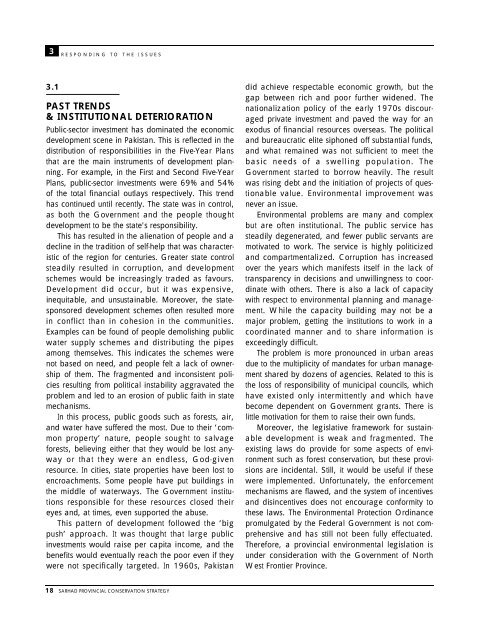Sarhad Provincial Conservation Strategy - IUCN
Sarhad Provincial Conservation Strategy - IUCN
Sarhad Provincial Conservation Strategy - IUCN
You also want an ePaper? Increase the reach of your titles
YUMPU automatically turns print PDFs into web optimized ePapers that Google loves.
3<br />
3 . 1<br />
R E S P O N D I N G T O T H E I S S U E S<br />
PAST TRENDS<br />
& INSTITUTIONAL DETERIORAT I O N<br />
Public-sector investment has dominated the economic<br />
development scene in Pakistan. This is reflected in the<br />
distribution of responsibilities in the Five-Year Plans<br />
that are the main instruments of development planning.<br />
For example, in the First and Second Five-Year<br />
Plans, public-sector investments were 69% and 54%<br />
of the total financial outlays respectively. This trend<br />
has continued until recently. The state was in control,<br />
as both the Government and the people thought<br />
development to be the state's responsibility.<br />
This has resulted in the alienation of people and a<br />
decline in the tradition of self-help that was characteristic<br />
of the region for centuries. Greater state control<br />
steadily resulted in corruption, and development<br />
schemes would be increasingly traded as favours.<br />
Development did occur, but it was expensive,<br />
inequitable, and unsustainable. Moreover, the statesponsored<br />
development schemes often resulted more<br />
in conflict than in cohesion in the communities.<br />
Examples can be found of people demolishing public<br />
water supply schemes and distributing the pipes<br />
among themselves. This indicates the schemes were<br />
not based on need, and people felt a lack of ownership<br />
of them. The fragmented and inconsistent policies<br />
resulting from political instability aggravated the<br />
problem and led to an erosion of public faith in state<br />
mechanisms.<br />
In this process, public goods such as forests, air,<br />
and water have suffered the most. Due to their ‘common<br />
property’ nature, people sought to salvage<br />
forests, believing either that they would be lost anyway<br />
or that they were an endless, God-given<br />
resource. In cities, state properties have been lost to<br />
encroachments. Some people have put buildings in<br />
the middle of waterways. The Government institutions<br />
responsible for these resources closed their<br />
eyes and, at times, even supported the abuse.<br />
This pattern of development followed the ‘big<br />
push’ approach. It was thought that large public<br />
investments would raise per capita income, and the<br />
benefits would eventually reach the poor even if they<br />
were not specifically targeted. In 1960s, Pakistan<br />
18 SARHAD PROVINCIAL CONSERVATION STRATEGY<br />
did achieve respectable economic growth, but the<br />
gap between rich and poor further widened. The<br />
nationalization policy of the early 1970s discouraged<br />
private investment and paved the way for an<br />
exodus of financial resources overseas. The political<br />
and bureaucratic elite siphoned off substantial funds,<br />
and what remained was not sufficient to meet the<br />
basic needs of a swelling population. The<br />
Government started to borrow heavily. The result<br />
was rising debt and the initiation of projects of questionable<br />
value. Environmental improvement was<br />
never an issue.<br />
Environmental problems are many and complex<br />
but are often institutional. The public service has<br />
steadily degenerated, and fewer public servants are<br />
motivated to work. The service is highly politicized<br />
and compartmentalized. Corruption has increased<br />
over the years which manifests itself in the lack of<br />
transparency in decisions and unwillingness to coordinate<br />
with others. There is also a lack of capacity<br />
with respect to environmental planning and management.<br />
While the capacity building may not be a<br />
major problem, getting the institutions to work in a<br />
coordinated manner and to share information is<br />
exceedingly difficult.<br />
The problem is more pronounced in urban areas<br />
due to the multiplicity of mandates for urban management<br />
shared by dozens of agencies. Related to this is<br />
the loss of responsibility of municipal councils, which<br />
have existed only intermittently and which have<br />
become dependent on Government grants. There is<br />
little motivation for them to raise their own funds.<br />
Moreover, the legislative framework for sustainable<br />
development is weak and fragmented. The<br />
existing laws do provide for some aspects of environment<br />
such as forest conservation, but these provisions<br />
are incidental. Still, it would be useful if these<br />
were implemented. Unfortunately, the enforcement<br />
mechanisms are flawed, and the system of incentives<br />
and disincentives does not encourage conformity to<br />
these laws. The Environmental Protection Ordinance<br />
promulgated by the Federal Government is not comprehensive<br />
and has still not been fully effectuated.<br />
Therefore, a provincial environmental legislation is<br />
under consideration with the Government of North<br />
West Frontier Province.

















